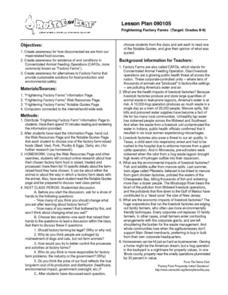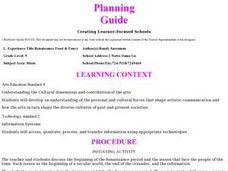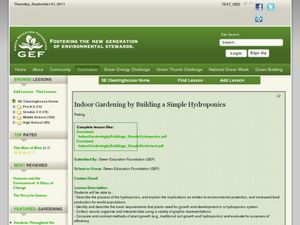Curated OER
Youth Obesity: Schools Fight Back
Kids fight obesity by comparing the USDA food intake suggestions to what they personally consume throughout the day. They watch a video, read texts, and explore related vocabulary which they use as they compose an oral presentation.
Curated OER
Food and Languages of the World
Third graders become familiar with the German pickle, part of the Christmas celebration in Germany. In this German pickle lesson, 3rd graders listen to the story of the German pickle and its significance to the German Christmas...
Curated OER
A Tough Nut to Crack
Sixth graders explore agriculture by examining world geography. In this pecan cultivation lesson plan, 6th graders identify the history of the famous nut and the impact it has on the U.S. economy, diet and human body. Students define...
Curated OER
Plants of the Rainforest
Students examine plants found in the rainforest, and discuss products that come from rainforest plants. They examine books about rainforest plants, list foods they have eaten that come from the rainforest, and have a rainforest party.
Curated OER
What's In Your Grocery Bag?
Students explore the global implications of consumer decisions when purchasing groceries. They examine labels of food products and discuss the wording on the labels. They calculate food miles of how far each ingredient in foods has...
Achieve
Yogurt Packaging
Food companies understand how to use math to their advantage. Learners explore the math related to the packaging and serving size of yogurt. They then use unit analysis and percent values to make decisions on the product development.
Curated OER
Is It Hog Wash, or Not?
Students investigate pathogens that can be present in pork products and summarize the responsibilities of pork farmers in ensuring the safety of their products. They also investigate the affects of hog farming on the environment and...
Curated OER
Thanksgiving Feast (Read the Charts)
Learners practice reading charts about foods country of origin. They interpret information and answer questions related to charts. They discover how food production adds to the economy.
DiscoverE
Slime!!
Who's going to get slimed? Your entire class! Scholars create slime using Borax, water, and white glue. Some food coloring can give the slime a bit of color.
Curated OER
Entrepreneur: Serving the Mature Adult
Tenth graders recognize the needs of older consumers for certain products. They apply creativity skills to develop a product that meets the needs of older consumers. In the end, they do a verbal presentation for a group of older consumers.
Curated OER
Agriculture Careers
Students study the careers available in the agricultural field. In this agriculture field instructional activity, students study the jobs required to getting a food product into someone's kitchen. Students select an agriculture career...
Winston-Salem Forsych County Schools
Economics Worksheet Economic Systems and Circular Flow
Agribusiness, human capital, productivity. Find out what your class members know about economic systems and terminology with this two-page economics worksheet that that asks kids to identify terms and concepts.
Curated OER
Frightening Factory Farms
Students discuss existence of and conditions on factory farms, and identify alternatives to factory farms that provide sustainable solutions for food production and environmental safety.
Curated OER
Breakfast of Champions
Second graders classify foods using the food pyramid and write about the foods they eat. They distinguish between healthy and junk food and make healthy choices for their meals. They listen to the story "No Peas for Nellie" and discuss...
Curated OER
Honey Bunches of Oats
Students explore a variety of crops that are used in our food products utalizing a box of the cereal, Honey "Bunches of Oates." Percentages of each of the three different kinds of flakes present are calculated.
Agriculture in the Classroom
Farmland: GMOs and Organic Agriculture
Learn more about genetic modification, organic farming, and the role of biotechnology in agriculture by watching a documentary that shows how newly gained knowledge can be applied to specific situations involving farmers and the choices...
Curated OER
Icecream in a Baggie
Students apply their comprehension of colligative properties to real-world situations. They review the concepts of physical and chemical changes. Students are reminded that science is used extensively in food-production. They are...
Curated OER
Renaissance Feast & Fancy
Ninth graders investigate the recreation, music, clothing, and food of the Renaissance period. In small groups, they research a topic, and plan activities, music, food, and costumes to be used in a Renaissance Feast.
Curated OER
Indoor Gardening by Building a Simple Hydroponics
Students investigate the use of hydroponic gardening on the world food supply. In this hydroponic gardening lesson, students make a garden out of a soda bottle, grow a cilantro plant, and compare hydroponics with regular gardening using...
Curated OER
Survival of Native American Culture
Students research the five tribes of the Iroquois Nation focusing on housing, food, clothing, transportation, religion, and language. They research using Internet sources and book mark sites for reuse.
University of Georgia
Antacid and Uncle Heartburn
Household materials can be used for more than cleaning! In this collaborative experiment, emerging chemists use products such as vinegar and liquid antacid to explore chemical reactions that commonly occur in the human body.
Curated OER
Check Out This Label
Students participate in a discussion on why food labels are important and how they were developed. Using the internet, they research what is meant by the 'use by' date and discover how the ingredients are listed on the package. They use...
Curated OER
From the Cow to You Mobile
In this food production instructional activity, students make a mobile that demonstrates the foods that come from a cow. The color pictures of a cow, and items such as milk and cheese to hang on the mobile.
Curated OER
Who's for Dinner?
Fifth graders examine life systems within different biomes. They choose paper plates with the names of animals on them. They research the animals, write reports and draw pictures of them. They create a food chain model by arranging the...
Other popular searches
- Food Production Flow Charts
- Food Production by Continent
- Hormones & Food Production
- Plant Food Production
- Food Production Chain
- Food Production Plan
- Energy and Food Production
- Tree Food Production
- Food Production Oil
- Mass Production Food
- Anthropology Food Production
- Bacteria in Food Production

























